RBSE Solutions for Class 12 Maths Chapter 6 Application of Derivatives Ex 6.1
Rajasthan Board RBSE Solutions for Class 12 Maths Chapter 6 Application of Derivatives Ex 6.1 Textbook Exercise Questions and Answers.
Rajasthan Board RBSE Solutions for Class 12 Maths in Hindi Medium & English Medium are part of RBSE Solutions for Class 12. Students can also read RBSE Class 12 Maths Important Questions for exam preparation. Students can also go through RBSE Class 12 Maths Notes to understand and remember the concepts easily.
RBSE Class 12 Maths Solutions Chapter 6 Application of Derivatives Ex 6.1
Question 1.
Find the rate of change of the area of a circle with respect to its radius r when
(a) r = 3 cm
(b) r = 4 cm
Answer:
(a) Let A be area of circle, A = πr2
Differentiating both sides w.r.t. r
Thus, rate of change of A w.r.t. r
\(\frac{d A}{d r}\) = 2πr
Thus, rate of change of A w.r.t r is \(\frac{d A}{d r}\) = 2πr
∴ At r = 3, \(\frac{d A}{d r}\) = 2πr × 3 = 6π cm2
Thus, when r = 3 cm, then rate of change in A w.r.t. r = 6π cm2/ sec.
(b) For r = 4, \(\frac{d A}{d r}\) = 2π × 4 = 8π cm2
Thus, when r = 4 cm, then rate of change in A = 8π cm2/ sec.

Question 2.
The volume of a cube is increasing at the rate of 8 cm3/sec. How fast in the Surface area increasing when the length of an edge is 12 cm?
Answer:
Let at any time t, length of an edge of cube is x and surface area is S. If volume of cube is V then
We have \(\frac{d V}{d t}\) = 8 cm3/sec ...... (1)
Now, volume of cube, V = x3
Differentiating w.r.t. t

Thus, surface area of cube is increasing at the rate of \(\frac{8}{3}\) cm2/sec.
Question 3.
The radius of circle is increasing uniformaly at the rate of 3 cm/sec. Find the rate at which the area of the circle is increasing when the radius is 10 cm.
Answer:
Let at any time t, r is radius of circle and A is its area.
∴ A = πr2
Differentiating w.r.t. t
\(\frac{d A}{d t}\) = 2πr\(\frac{d r}{d t}\) ....... (1)
Given, \(\frac{d r}{d t}\) = 3 cm/sec
Then, from equation (1), \(\frac{d A}{d t}\) = 2πr.3 = 6πr
When r = 10, then \(\frac{d A}{d t}\) = 6π × 10 = 60π cm2/sec
Thus, the area of circle is increasing at the rate of 60 π cm3/sec.

Question 4.
An edge of a variable cube is increasing at the rate of 3 cm/sec. How fast is the volume of the cube increasing when the edge Is 10 cm long?
Answer:
Let at any time t, edge of cube is x and volume is V.
∴ V = x3
Differentiating w.r.t. t
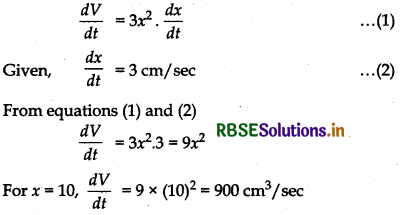
Thus, the volume of cube is increasing at the rate of 900 cm3/sec
Question 5.
A stone is dropped into a quiet lake and waves move in circles at the speed of 5 cm/sec. At the instant when the radius of circular wave is 8 cm, how fast is the enclosed area increasing?
Answer:
Let at any time t, radius of circular wave is r and enclosed area is A.
∴ A = πr2
Differentiating w.r.t. t
\(\frac{d A}{d t}\) = 2πr × \(\frac{d r}{d t}\) ......... (1)
Given, \(\frac{d r}{d t}\) = 5 cm/sec .......... (2)
From equations (1) and (2)
\(\frac{d A}{d t}\) = 2πr × 5 = 10πr
For r = 8 cm, \(\frac{d A}{d t}\) = 10 × π × 8 = 80π cm2/sec
Thus, the enclosed area A is increasing at the rate of 80π cm2/sec.
Question 6.
The radius of a circle is increasing at the rate of 0.7 cm/sec. What is the rate of increase of its circumference?
Answer:
Let at any time t, radius of circle is r and circumference is C.
Then C = 2πr
Differentiating w.r.t t
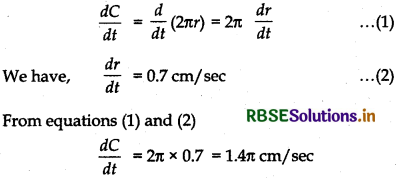
Thus, circumference of circle is increasing at the rate 1.4π cm/sec.

Question 7.
The length x of a rectangle is decreasing at the rate of 5 cm/min and width y is increasing at the rate of4cnmin.When x = 8 cm and y = 6cm find the rates of change of (a) the perimeter, and (b) the area of the rectangle.
Answer:
Let at any time t, P is perimeter of rectangle and
A is its area.
(a) Perimeter P = 2(x + y)
Differentiating wr.t. t
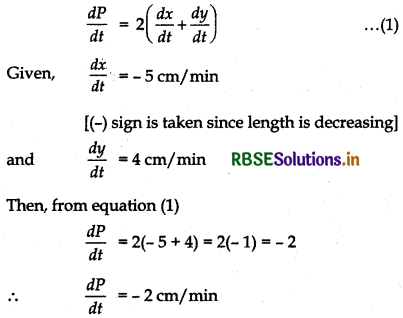
Thus, the perimeter of rectangle is decreasing at the rate of 2 cm/min.
(b) Area of rectangle, A = x × y
Differentiating w.r.t. t
\(\frac{d A}{d t}\) = x . \(\frac{d y}{d t}\) + y. \(\frac{d x}{d t}\) ....... (2)
Substituting the values of and in equation (2)
\(\frac{d A}{d t}\) = x × 4 + y.(- 5) = 4x - 5y
Given, x = 8 cm and y = 6cm
\(\frac{d A}{d t}\) = 4 × 8 - 5 × 6 = 32 - 30 = 2
Thus, the area of rectangle is decreasing at the rate of 2 cm2/min.
Question 8.
A balloon, which always remains spherical on inflation, is being inflated by pumping in 900 cubic centimetres of gas per second. Find the rate at which the radius of the balloon increases when the radius is 15 cm.
Answer:
Let at any time t, radius of balloon is r and its volume is V.

Thus, the rate of change in radius of balloon is \(\frac{1}{\pi}\) cm/sec

Question 9.
A balloon, which always remains spherical has a variable radius. Find the rate at which its volume is increasing with the radius when the radius is 10 cm.
Answer:
Let V be the volume and r is radius of balloon.

Thus, the rate of change of volume of balloon w.r.t. radius is 400π cm3/ sec.
Question 10.
A ladder 5m long is leading against a wall. The bottom of the ladder is pulled along the ground away from the wall at the rate of 2 cm/sec. How fast is height on the wall decreasing when the foot of the ladder is 4 m away from the wall?
Answer:
Let AB and AC be two position of ladder at any time t such that AB = y and BC = x.
In right-angled ∆ ABC
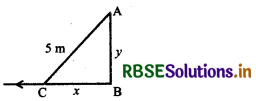
AC2 = AB2 + BC2 3m
⇒ 52 = y2 + x2
⇒ x2 + y2 = 25 ...... (1)
For x = 4
42 + y2 = 25 [from (1)1
⇒ 16 + y2 = 25 ⇒ y2 = 25 - 16 = 9
∴ y = 3m
Differentiating equation (1) w.r.t. t
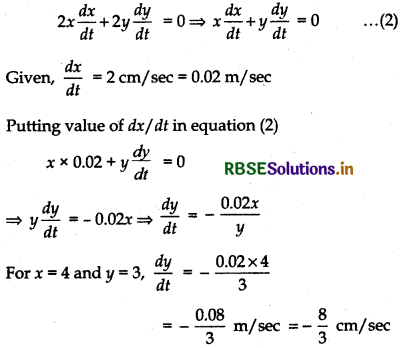
Hence, the rate of decreasing in the height of the ladder is \(\frac{8}{3}\) cm/sec.
Question 11.
A particle is moving along the curve 6y = x3 + 2. Find the points on the curve at which the y-coordinate is changing 8 times as fast as the x coordinate.
Answer:
Differentiating curve 6y = x3 + 2 w.r.t. y
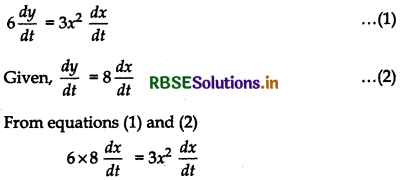
⇒ 48 = 3x2 ⇒ x2 = 16 ⇒ x = ±4
For x = 4 6y = x3 + 2
⇒ 6y = (4)3 + 2 = 64 + 2 = 66
∴ y = 11
For x = - 4 6y = (-4)3 + 2 = - 64 + 2 = - 62
∴ y = - \(\frac{62}{6}\) = - \(\frac{31}{3}\)
∴ Required points are (4, 11) and (- 4, - \(\frac{31}{3}\)).

Question 12.
The radius of an air bubble is increasing at the rate of \(\frac{1}{2}\)cm/sec. At what rate is the volume of the bubble increasing when the radius is 1 cm?
Answer:
Let at any time t, r is the radius of air bubble and V is its volume.
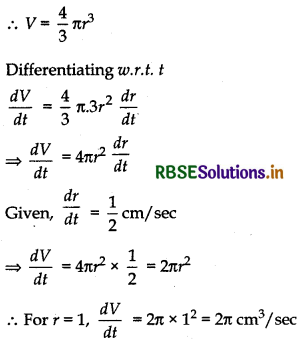
Hence, volume of air bubble is increasing at the rate of 2π cm3/sec.
Question 13.
A balloon, which always remains spherical, has a variable diameter \(\frac{3}{2}\)(2x + 1). Find the rate of change of its volume with respect to x.
Answer:
Let the volume of the balloon is V.

Rate of change of volume w.r.t. x is \(\frac{27 \pi}{8}\)(2x + 1)2
Question 14.
Sand is pouring from a pipe at the rate of 12 cm3/sec. The falling sand forms a cone on the ground in such a way that the height of the cone is always one sixth of the radius of the base. How fast is the height of the sand cone increasing when the height is 4 cm?
Answer:
Let at any time t, volume of sand cone is V, height is h and radius is r.
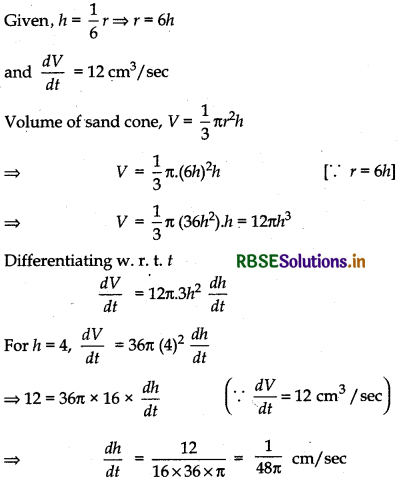
Thus, the height of sand cone is increasing at the rate of \(\frac{1}{48 \pi}\) cm/sec.

Question 15.
The total cost C(x) in rupees associated with the production of x units of an item is given by
C(x) = 0.007x3 - 0.003x2 + 15x + 4000
Find the marginal cost whereas 17 units are produced.
Answer:
We have, cost of production of x items is C(x).
where C(x) = 0.007x3 - 0.003x2 + 15x + 4000
Marginal cost = MC
∵ MC = \(\frac{d}{d x}\) C(x)
∴ MC = \(\frac{d}{d x}\) (0.007x3 - 0.003x2 + 15x + 4000)
= 0.007 \(\frac{d}{d x}\) (x3) - 0.003 \(\frac{d}{d x}\) (x2) + 15 \(\frac{d}{d x}\) (x) + \(\frac{d}{d x}\) (4000)
= 0.007 × 3x2 - 0.003 × 2x + 15 × 1 + 0
For x = 17
MC = 0.007 × 3 × (17)2 - 0.003 × 2(17) + 15
= 0.007 × 3 × 289 - 0.003 × 2 × 17 + 15
= 6.069 - 0.102 + 15 = 21.069 - 0.102
= 20.967 = 20.97
Thus, marginal cost = ₹ 20.97 (approx.)
Question 16.
Total revenue in rupees received from the sale of x units of a product is given by
R(x) = 13x2 + 26x + 15
Find the marginal revenue when x = 7.
Answer:
Equation for revenue
R(x) = 13x2 + 26x + 15
Marginal revenue = MR = \(\frac{d}{d x}\) [R(x)]
⇒ MR = \(\frac{d}{d x}\) (13x2 + 26x + 15)
⇒ MR = 13 \(\frac{d}{d x}\) (x2) + 36 \(\frac{d}{d x}\) (x) + \(\frac{d}{d x}\) (15)
⇒ MR = 13 × 2x + 26 × 1 + 0
⇒ MR = 26x + 26 = 26(x + 1)
For x = 7, MR = 26(7 + 1) = 26 × 8 = 208
Hence, marginal revenue is ₹ 208.
Choose the correct answer in Q. 17 and Q. 18
Question 17.
The rate of change of the area of a circle with respect to its radius at r 6 cm is:
(A) 10π
(B) 12π
(C) 8π
(D) 11π
Answer:
Let A be the area of circle.
∴ A = πr2
Differentiating w.r.t. r
\(\frac{d A}{d r}\) = 2πr
For r = 6, \(\frac{d A}{d r}\) = 2π × 6 = 12π
Thus, (B) is correct.

Question 18.
The total revenue in rupees received from the sale of x unit of a product is given by R(x) = 3x2 + 36x + 5. The marginal revenue when x = 15 is:
(A) ₹ 116
(B) ₹ 96
(C) ₹ 90
(D) ₹ 126
Answer:
Equation for revenue
R(x) = 3x2 + 36x +5
Marginal revenue = MR = \(\frac{d}{d x}\) [R(x)]
MR = \(\frac{d}{d x}\) (3x2 + 36x + 5)
MR = 13\(\frac{d}{d x}\)(x2) + 36\(\frac{d}{d x}\)(x) + \(\frac{d}{d x}\)(15)
MR = 3 × 2x + 36 × 1 + 0 = 6x + 36
For x = 15, MR = 6 × 15 + 36 = ₹126
Thus, (D) is correct.

- RBSE Class 12 Maths Notes Chapter 13 Probability
- RBSE Class 12 Maths Notes Chapter 12 Linear Programming
- RBSE Class 12 Maths Notes Chapter 11 Three Dimensional Geometry
- RBSE Class 12 Maths Notes Chapter 10 Vector Algebra
- RBSE Class 12 Maths Notes Chapter 9 Differential Equations
- RBSE Class 12 Maths Notes Chapter 8 Application of Integrals
- RBSE Class 12 Maths Notes Chapter 7 Integrals
- RBSE Class 12 Maths Notes Chapter 6 Application of Derivatives
- RBSE Class 12 Maths Notes Chapter 5 Continuity and Differentiability
- RBSE Class 12 Maths Notes Chapter 4 Determinants
- RBSE Class 12 Maths Notes Chapter 3 Matrices